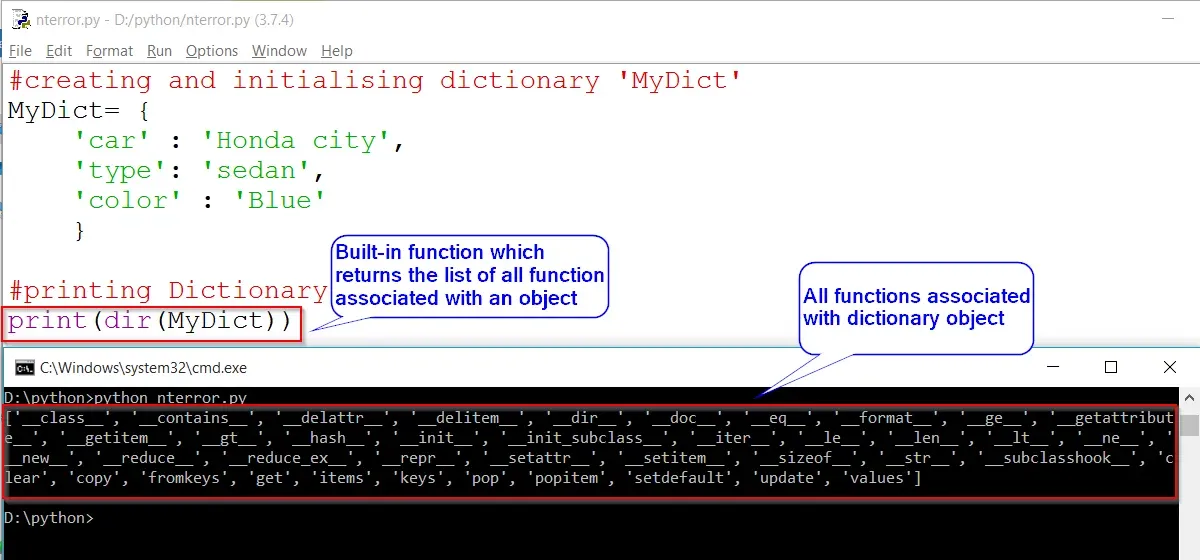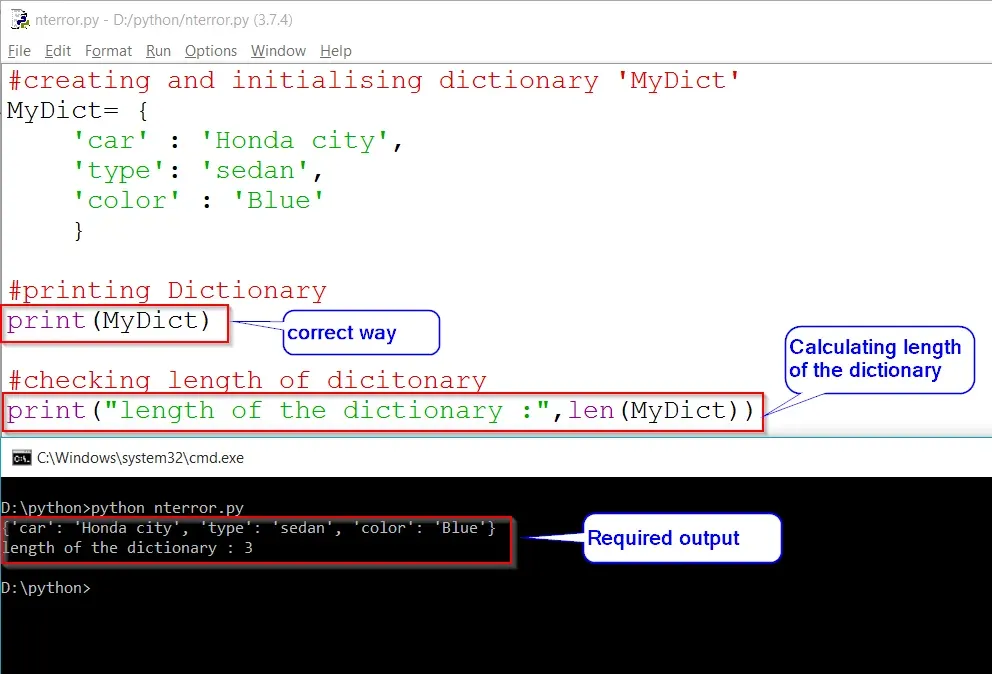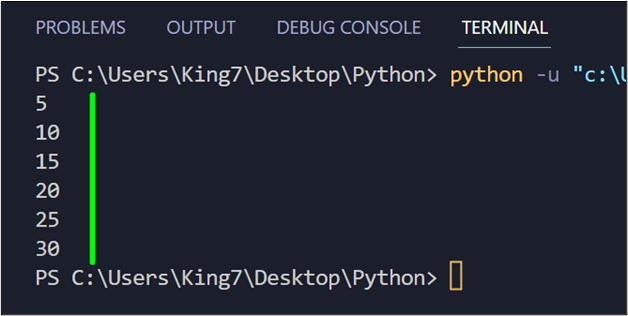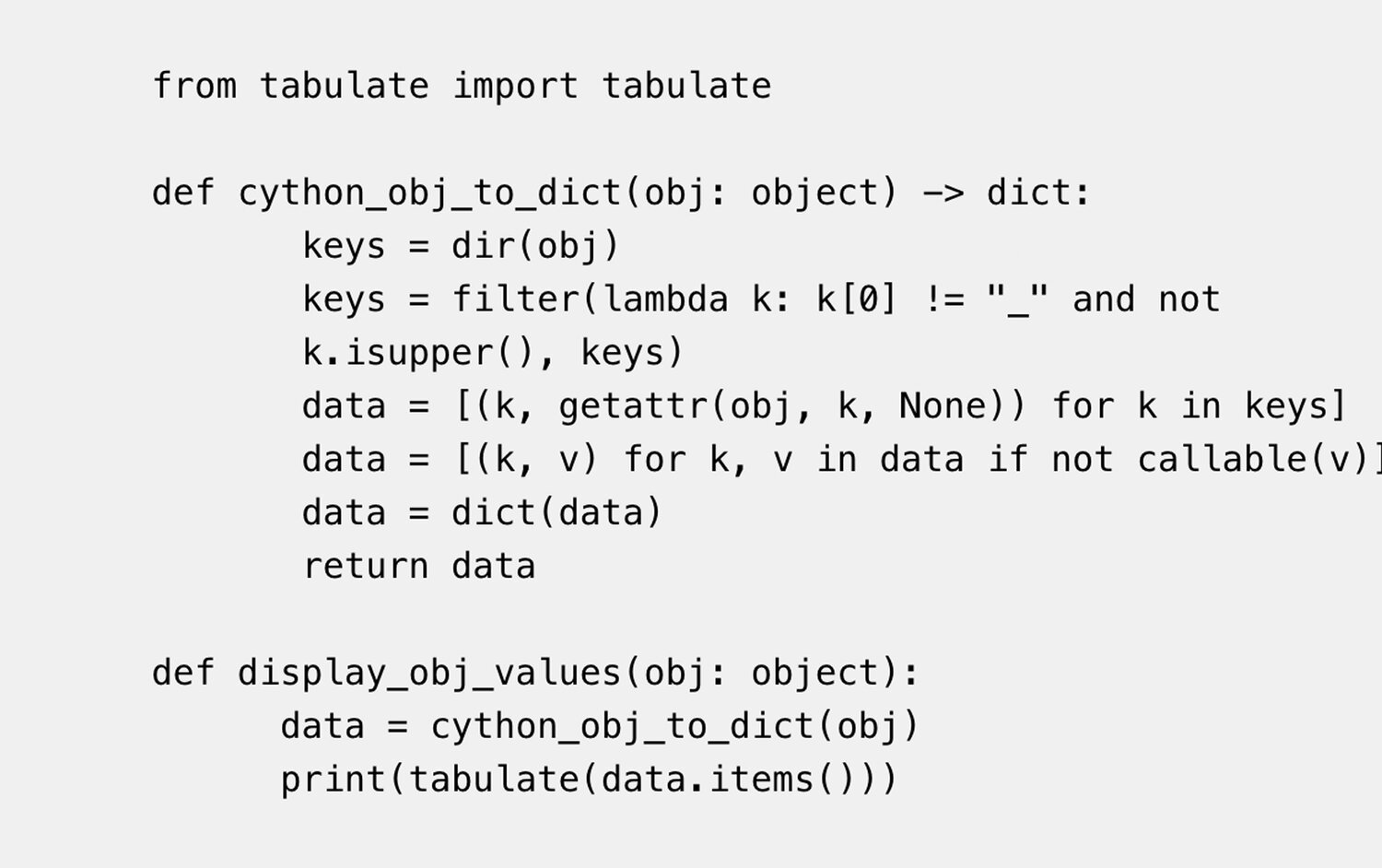‘Dict’ Object Is Not Callable
When working with dictionaries in Python, you may encounter the ‘dict’ object is not callable error. This error typically occurs when you try to access a dictionary using incorrect syntax or when there is a mismatch in variable types. In this article, we will explore the common causes of this error and provide solutions to help you resolve it.
Common Causes of the ‘dict’ object is not Callable Error:
1. Missing Parentheses in Dictionary Access:
One common cause of this error is when you forget to include parentheses while accessing a value from a dictionary. Here’s an example:
my_dict = {‘key’: ‘value’}
print(my_dict[‘key’]) # Correct syntax
print(my_dict(‘key’)) # Causes the ‘dict’ object is not callable error
Solution: To fix this error, make sure you use square brackets ‘[]’ instead of parentheses ‘()’ when accessing dictionary values.
2. Incorrect Syntax in Dictionary Access:
Another possible cause of this error is using incorrect syntax while accessing dictionary values. This can include using the wrong delimiter or missing quotation marks around the key. For instance:
my_dict = {‘key’: ‘value’}
print(my_dict[key]) # Incorrect syntax – missing quotation marks
print(my_dict(‘key’)) # Causes the ‘dict’ object is not callable error
Solution: To resolve this error, double-check the syntax and ensure that you are using the correct delimiter (square brackets) and quotation marks when accessing dictionary values.
3. Incorrect Variable Type in Dictionary Access:
The ‘dict’ object is not callable error can also occur when you try to access dictionary values using a variable of the wrong type. For example:
my_dict = {‘key’: ‘value’}
my_key = ‘key’
print(my_dict[my_key]) # Correct syntax
print(my_dict[{‘key’: ‘value’}]) # Causes the ‘dict’ object is not callable error
Solution: To overcome this error, ensure that the variable you are using to access dictionary values is of the correct type, which should be a string or an integer.
Solutions for the ‘dict’ object is not Callable Error:
1. Adding Parentheses to Dictionary Access:
As mentioned earlier, the ‘dict’ object is not callable error can occur due to missing parentheses when accessing dictionary values. To resolve this, you need to replace the parentheses with square brackets. Here’s an example:
my_dict = {‘key’: ‘value’}
print(my_dict[‘key’]) # Corrected syntax
2. Verifying Syntax in Dictionary Access:
Check for any syntax errors when accessing dictionary values, such as missing quotation marks or incorrect delimiters. By ensuring the syntax is correct, you can avoid the ‘dict’ object is not callable error. Here’s an illustration:
my_dict = {‘key’: ‘value’}
print(my_dict[‘key’]) # Corrected syntax
3. Ensuring Correct Variable Type in Dictionary Access:
To avoid the ‘dict’ object is not callable error, verify that the variable used to access dictionary values is of the correct type. If the variable is a string or an integer, it should work correctly. For instance:
my_dict = {‘key’: ‘value’}
my_key = ‘key’
print(my_dict[my_key]) # Corrected syntax
In addition to the common causes and solutions, there are several related topics and keywords that are often searched for in relation to this error. Let’s explore these topics briefly:
– **Dict object is not callable PyTorch:** This refers to a specific instance of the error that occurs while working with the PyTorch library. The solutions mentioned earlier should still apply, but be aware of any specific requirements or variations when using PyTorch.
– **For key-value in dict Python:** This is a popular Python construct used for iterating over key-value pairs in a dictionary. It allows you to access both the key and value within a loop.
– **Unhashable type: ‘dict’:** This error occurs when trying to use a dictionary as a key for another dictionary or a set since dictionaries are mutable and cannot be hashed. The key to resolving this error is to use immutable types as keys, such as strings or numbers.
– **Get value in dict Python:** To retrieve a specific value from a dictionary, you can use the square bracket notation, providing the key of the desired value. For example: `my_dict[‘key’]` will return the corresponding value.
– **Get key, value in dict Python:** As mentioned earlier, the ‘for key, value in dict’ construct enables you to iterate over both the key and value of each item in a dictionary.
– **Python dict set value:** To set or update a value in a dictionary, you can access it using the key and assign a new value. For example: `my_dict[‘key’] = ‘new_value’` will update the value corresponding to the ‘key’ in the dictionary.
– **Order dict Python:** Dictionaries in Python do not have a specific order by default. However, starting from Python 3.7, dictionaries maintain the insertion order. If you need to preserve a specific order, you can make use of the OrderedDict class from the collections module.
– **Print dict Python:** To print the contents of a dictionary, use the ‘print()’ function with the dictionary itself as the argument. This will display the key-value pairs in a readable format.
In conclusion, encountering the ‘dict’ object is not callable error can be frustrating, but with a clear understanding of the causes and solutions, you can easily overcome it. By verifying syntax, ensuring correct variable types, and using the appropriate access methods, you can effectively access and manipulate dictionary values in Python.
Frequently Asked Questions (FAQs):
Q1: What does the ‘dict’ object is not callable error mean in Python?
A1: This error usually occurs when there is an issue with accessing dictionary values, such as missing parentheses, incorrect syntax, or attempting to use a variable of the wrong type.
Q2: How do I fix the ‘dict’ object is not callable error?
A2: To fix this error, ensure that you use the correct syntax (square brackets instead of parentheses), provide the appropriate variable type, and validate the delimiter and quotation marks used when accessing dictionary values.
Q3: Can this error occur when working with PyTorch?
A3: Yes, it is possible to encounter this error while using the PyTorch library. However, the solutions mentioned in this article should still apply, although it’s important to consider any specific requirements or variations when working with PyTorch.
Q4: What is an unhashable type: ‘dict’ error?
A4: This error occurs when trying to use a dictionary as a key for another dictionary or a set since dictionaries are mutable and cannot be hashed. Ensure that you use immutable types, such as strings or numbers, as keys to avoid this error.
Q5: How can I retrieve a specific value from a dictionary in Python?
A5: To retrieve a value from a dictionary, use the square bracket notation with the key as the index. For example, `my_dict[‘key’]` will return the corresponding value.
Q6: How can I iterate over key-value pairs in a dictionary?
A6: Python provides the ‘for key, value in dict’ construct to iterate over key-value pairs in a dictionary. This allows you to access both the key and value within a loop.
Q7: Is there a way to preserve the order of a dictionary in Python?
A7: Starting from Python 3.7, dictionaries maintain the insertion order by default. However, if you need to preserve a specific order, you can make use of the OrderedDict class from the collections module.
Q8: How can I print the contents of a dictionary in Python?
A8: To print the contents of a dictionary, use the ‘print()’ function with the dictionary itself as the argument. This will display the key-value pairs in a readable format.
Typeerror Dict Object Is Not Callable – Solved
What Does Dict Is Not Callable Mean?
Python is a widely used programming language known for its simplicity and readability. However, when writing code, it’s not uncommon to encounter errors or exceptions. One such error that programmers often encounter is the “dict is not callable” error message. In this article, we will explore what this error means, why it occurs, and how to fix it.
Understanding the Error:
To understand the “dict is not callable” error, we need to first understand what a dict is in Python. The term “dict” is short for a dictionary, which is a built-in data type that stores key-value pairs. It is similar to a real-world dictionary, where each word (key) is associated with its definition (value).
In Python, you can create a dictionary by enclosing comma-separated key-value pairs within curly braces {}. For example:
my_dict = {‘key1’: ‘value1’, ‘key2’: ‘value2’}
The error message “dict is not callable” usually occurs when we incorrectly try to call or invoke the dictionary as if it were a function. In other words, we are attempting to use the dictionary as if it were a callable object, but dictionaries are not callable.
Common Causes of the Error:
1. Incorrect Syntax: One common cause of this error is when we mistakenly use parentheses () to access dictionary values instead of using square brackets []. For example:
my_dict = {‘key1’: ‘value1’, ‘key2’: ‘value2’}
print(my_dict(‘key1’))
In this example, we are using parentheses to access the value associated with the ‘key1’ key, which leads to the “dict is not callable” error. To fix this, we need to use square brackets instead:
print(my_dict[‘key1’])
2. Missing or Incorrect Key: Another cause of this error is when we try to access a key that does not exist in the dictionary. For instance:
my_dict = {‘key1’: ‘value1’, ‘key2’: ‘value2’}
print(my_dict[‘key3’])
Here, we are trying to access a non-existent key ‘key3’, resulting in the “dict is not callable” error. To avoid this, ensure that the key you’re trying to access actually exists in the dictionary.
3. Overwriting the dict Function: Python has a built-in function called “dict()” that can be used to create dictionaries. If you accidentally assign a value to the “dict” name, you lose access to the built-in dict function, causing the error. For example:
dict = {‘key’: ‘value’}
print(dict())
In this example, we assigned a value to the “dict” name, making it inaccessible as a function. To fix this, avoid using reserved function names as variable names.
How to Fix the Error:
To fix the “dict is not callable” error, examine your code and identify the cause of the issue. Once you have identified the issue, apply the appropriate fix:
1. Check the Syntax: Make sure you are using square brackets [] to access dictionary values, and not parentheses (). For example, use my_dict[‘key1’] instead of my_dict(‘key1’).
2. Verify the Key: Ensure that the key you are trying to access actually exists in the dictionary. Double-check for any typos or missing keys that could be causing the error.
3. Avoid Overwriting the dict Function: If you accidentally assigned a value to the “dict” name, rename the variable to something else. This will restore access to the built-in dict function.
Frequently Asked Questions:
1. What is a dictionary in Python?
A dictionary is a built-in data type in Python that stores key-value pairs. It allows quick access to values based on their associated keys.
2. What does “callable” mean in Python?
In Python, callable refers to an object or entity that can be called or invoked as a function. This includes built-in functions, user-defined functions, and certain classes.
3. Can dictionaries be called as functions?
No, dictionaries cannot be called as functions. They are not callable objects.
4. How do I access values in a dictionary?
To access values in a dictionary, use square brackets [] and provide the key of the desired value. For example, my_dict[‘key’] will retrieve the value associated with ‘key’ in the dictionary.
5. How can I avoid the “dict is not callable” error?
By ensuring that you correctly access dictionary values using square brackets [], verify that the key you are trying to access exists in the dictionary, and avoid overwriting the dict function name.
In conclusion, the “dict is not callable” error occurs when trying to use a dictionary as if it were a function. By understanding the causes and applying the appropriate fixes, you can overcome this error and write error-free Python code.
Why Is An Object Not Callable In Python?
In Python, an object is not callable when it lacks the necessary functionality to be invoked as a function. This means that it cannot be executed with parentheses after its name, like a regular function. The inability to call an object is often a result of the object lacking either the `__call__()` method or the `() `operator. This distinction is crucial to understanding the concept of callable objects in Python.
Understanding Callable Objects:
In Python, a callable object is one that can be treated and invoked as a function. This means that the object can be called using parentheses and arguments, much like how we invoke a built-in function or a user-defined function. Examples of callable objects include functions, methods, classes, and certain class instances. They all possess either the `__call__()` method or the `()` operator, or both.
The `__call__()` Method:
The `__call__()` method is a special method defined within a class that allows an instance of that class to be called as a function. When an instance is called using parentheses and arguments, Python automatically invokes this method. By defining the `__call__()` method, an object can acquire the ability to be invoked as a function.
Consider the following example:
“`python
class Adder:
def __init__(self, num):
self.num = num
def __call__(self, x):
return x + self.num
add_5 = Adder(5)
result = add_5(10) # Output: 15
“`
In the above code, the class `Adder` has defined the `__call__()` method, turning instances of `Adder` into callable objects. The `__init__()` method initializes the `num` attribute, while the `__call__()` method performs the addition operation. The `add_5` instance can now be called like a function, taking `10` as an argument and returning `15`.
The `()` Operator:
While most callable objects rely on the `__call__()` method, some objects are made callable by implementing the `()` operator. Instances of such objects behave like functions when called using parentheses and arguments.
Take a look at the following example:
“`python
class Multiplier:
def __call__(self, x, y):
return x * y
multiply = Multiplier()
result = multiply(4, 5) # Output: 20
“`
In the above code, the class `Multiplier` implements the `__call__()` method, allowing instances of `Multiplier` to be invoked as functions. The `multiply` instance, created from the `Multiplier` class, takes two arguments within the parentheses and returns their product.
Reasons for Objects Being Not Callable:
1. Missing the `__call__()` method: If an object does not have the `__call__()` method defined within its class, it cannot be invoked as a function. This lack of functionality prevents the object from being called, whether it’s a built-in data type or a custom object.
2. Immutable objects: Immutable objects, such as integers, floating-point numbers, and strings, lack the `__call__()` method by default. Due to their immutability, they do not possess the ability to be modified or invoked as functions. Attempting to call an immutable object will result in a `TypeError` indicating that the object is not callable.
3. Incomplete definition: If a custom object does not define the `__call__()` method properly, it will not be callable. This can occur when the method is defined with incorrect arguments or does not return the expected output.
FAQs:
Q: Can I make a non-callable object callable in Python?
A: Yes, by defining the `__call__()` method within the object’s class, you can make it callable. However, this requires modifying the class definition or subclassing the object to add this functionality.
Q: Is it possible to determine if an object is callable in Python?
A: Yes, you can use the `callable()` built-in function in Python, which returns `True` if the object is callable; otherwise, it returns `False`. This can be useful when dealing with different types of objects and dynamically checking their callability.
Q: Why does Python have non-callable objects?
A: Python allows non-callable objects to maintain a clear distinction between objects that are designed to be invoked as functions and those that are not. This design choice enables better code organization and helps prevent potential errors or unexpected behavior when calling objects.
Q: How can I handle a situation where an object is not callable?
A: When encountering a non-callable object, you can adjust your code to use alternative approaches, like treating the object as a value or using the object’s attributes or methods directly, based on the object’s intended purpose.
In conclusion, the ability to call objects in Python depends on the presence of either the `__call__()` method or the `()` operator. While many objects can be called as functions, certain objects lack the necessary functionality to be invoked in this manner. Understanding the distinction between callable and non-callable objects is vital for writing effective and error-free Python code.
Keywords searched by users: ‘dict’ object is not callable Dict object is not callable pytorch, For key-value in dict Python, Unhashable type: ‘dict, Get value in dict Python, Get key, value in dict Python, Python dict set value, Order dict Python, Print dict Python
Categories: Top 13 ‘Dict’ Object Is Not Callable
See more here: nhanvietluanvan.com
Dict Object Is Not Callable Pytorch
When working with PyTorch, a popular deep learning framework, it is not uncommon to come across the error message “Dict object is not callable.” This error can be quite frustrating, especially for beginners, as it disrupts the smooth progress of their code execution. In this article, we will delve deep into understanding this error message, explore its possible causes, and provide effective solutions to resolve it.
Understanding the Error Message: ‘Dict object is not callable’
The error message “Dict object is not callable” typically occurs when attempting to access or modify an element within a dictionary-like data structure in PyTorch. The error is primarily associated with incorrect usage of indexing or calling methods on a dictionary object. It signifies that the operation being performed on the dictionary is not valid or supported.
Possible Causes of the Error:
1. Incorrect Syntax: One common cause of this error is typographical errors, such as mistyping a method name or using incorrect parentheses or brackets while performing operations on the dictionary object.
2. Variable Conflict: Another cause could be a variable conflict in your code. If you accidentally overwrite a variable that was previously used as a dictionary with a different type of object, it can lead to unexpected behavior and the “Dict object is not callable” error.
3. Invalid Indexing: Incorrect usage of indexing or trying to access non-existent keys in the dictionary can also trigger this error. It is important to ensure that the key you are trying to access exists in the dictionary.
Effective Solutions for Resolving the Error:
1. Verify Syntax: Carefully review your code for any typos or syntax errors. Double-check method names, parentheses, and brackets. Ensure that the syntax aligns with the PyTorch documentation and guidelines.
2. Check Variable Assignments: Review your code to ensure that no variables with conflicting names are being used. Avoid overwriting any variables that were previously used as dictionary objects.
3. Validate Dictionary Keys: Before accessing or modifying any elements in the dictionary, verify that the keys you are using actually exist in the dictionary. Use the “in” operator to check if a key is present before attempting any operations.
4. Check for Shadowing: Shadowing occurs when a variable’s scope is overshadowed by another variable with the same name but a different type. Ensure that you are not accidentally shadowing a dictionary variable with another object of a different type.
FAQs:
Q1. Why am I getting the “Dict object is not callable” error while running my PyTorch code?
A1. This error typically occurs due to incorrect syntax, variable conflicts, or invalid indexing when accessing or modifying dictionary objects. Review your code for any typos, variable conflicts, and ensure valid key indexing.
Q2. How can I identify the specific line of code that triggers the error?
A2. The error message will generally provide a traceback, indicating the specific line of code where the error occurred. Inspect the traceback to locate the source of the issue and focus your troubleshooting efforts on that code snippet.
Q3. What should I do if the dictionary key I am trying to access or modify does not exist?
A3. Ensure that the key you are trying to access or modify actually exists in the dictionary. Use the “in” operator to check if the key is present before attempting any operations. Alternatively, consider using the “get” method to retrieve values, which allows you to set a default value if the key does not exist.
Q4. How can I prevent encountering this error in the future?
A4. To prevent encountering the “Dict object is not callable” error, enforce good coding practices such as carefully reviewing your code for typos, double-checking variable assignments, validating keys before accessing elements, and avoiding variable shadowing.
In conclusion, encountering the “Dict object is not callable” error in PyTorch can be resolved by carefully reviewing code syntax, ensuring proper variable assignments, and validating dictionary keys before performing operations. By following the solutions provided in this article and adopting good coding practices, you can overcome this error and continue building successful projects using PyTorch.
For Key-Value In Dict Python
Python, being a powerful and versatile programming language, offers a wide range of data structures. One of the most commonly used data structures in Python is the dictionary, also known as dict. Dict is an unordered collection of key-value pairs, where each key must be unique. Dicts are known for their efficient key lookup capabilities and their ability to store a wide variety of data types. In this article, we will delve into the concept of key-value in dict Python, covering the basics and exploring advanced techniques.
## Understanding Key-Value Pairs in Dict
Key-value pairs are the building blocks of a dict in Python. Each key-value pair consists of a key separated from its corresponding value by a colon (:). The pairs themselves are separated by commas. Let’s take a look at a basic example:
“`
my_dict = {“name”: “John”, “age”: 25, “city”: “New York”}
“`
In this example, `”name”`, `”age”`, and `”city”` are the keys, while `”John”`, `25`, and `”New York”` are their respective values. The order of the key-value pairs may not necessarily be maintained in dict since it is an unordered data structure.
## Accessing Values in Dict
Once we have a dict, we can access its values using the associated keys. This can be done using the square bracket notation or the `get()` method. Here’s an example:
“`
print(my_dict[“name”]) # Output: John
print(my_dict.get(“age”)) # Output: 25
“`
In the first line, we access the value associated with the key `”name”` using square brackets. In the second line, we achieve the same result using the `get()` method. The `get()` method has an added advantage since it returns `None` if the key is not found, while the square bracket notation would raise a `KeyError`.
## Modifying and Adding Key-Value Pairs
Dicts in Python are mutable, meaning we can modify its contents. To modify or add a key-value pair, we can simply assign a new value to the desired key or create a new key-value pair. Consider the following example:
“`
my_dict[“name”] = “Alice”
my_dict[“occupation”] = “Engineer”
“`
In the first line, we modify the value associated with the key `”name”` to `”Alice”`. In the second line, we add a new key-value pair with `”occupation”` as the key and `”Engineer”` as its value. The resulting dict would now be:
“`
{“name”: “Alice”, “age”: 25, “city”: “New York”, “occupation”: “Engineer”}
“`
## Removing Key-Value Pairs
Removing key-value pairs from a dict can be achieved using the `del` keyword or the `pop()` method. Let’s take a look at an example:
“`
del my_dict[“age”]
my_dict.pop(“city”)
“`
In the first line, we remove the key-value pair associated with the key `”age”` using the `del` keyword. In the second line, we achieve the same result using the `pop()` method. The resulting dict would now be:
“`
{“name”: “Alice”, “occupation”: “Engineer”}
“`
## Useful Methods for Dict Manipulation
Python provides several useful methods for manipulating dicts. Let’s explore some of them:
– `keys()`: This method returns a list of all the keys in the dict.
– `values()`: This method returns a list of all the values in the dict.
– `items()`: This method returns a list of tuples, where each tuple contains a key-value pair.
Here’s an example:
“`python
my_dict = {“name”: “John”, “age”: 25, “city”: “New York”}
print(my_dict.keys()) # Output: [“name”, “age”, “city”]
print(my_dict.values()) # Output: [“John”, 25, “New York”]
print(my_dict.items()) # Output: [(“name”, “John”), (“age”, 25), (“city”, “New York”)]
“`
## FAQ
**Q: Can a dict have multiple values for the same key?**
A: No, each key in a dict must be unique. If the same key is used multiple times, the later values will overwrite the earlier ones.
**Q: Can we use any data type as a key in a dict?**
A: No, not all data types can be used as keys in Python. Keys must be hashable, which means they need to be immutable. Commonly used data types as dict keys include strings, numbers, and tuples.
**Q: Can we iterate over a dict in Python?**
A: Yes, we can iterate over a dict using loops such as `for key in my_dict:`. This will iterate over the keys of the dict. To iterate over both keys and values, we can use the `items()` method.
**Q: How do we check if a key exists in a dict?**
A: We can use the `in` keyword to check if a key exists in a dict. For example: `if “name” in my_dict:`.
In conclusion, understanding key-value pairs in dict Python is fundamental to effectively working with this essential data structure. Through this article, we have covered the basics of accessing, modifying, and removing key-value pairs, as well as useful methods for dict manipulation. Dicts provide a powerful way to store and retrieve data, making them a versatile tool for various applications in Python programming.
Images related to the topic ‘dict’ object is not callable

Found 26 images related to ‘dict’ object is not callable theme
















































![TypeError: module object is not callable [Python Error Solved] Typeerror: Module Object Is Not Callable [Python Error Solved]](https://www.freecodecamp.org/news/content/images/2023/04/ihechikara-pfp.jpg)
![Typeerror: 'dict' object is not callable [SOLVED] Typeerror: 'Dict' Object Is Not Callable [Solved]](https://itsourcecode.com/wp-content/uploads/2021/01/IT-SOURCECODE_ICON-07.jpg)
Article link: ‘dict’ object is not callable.
Learn more about the topic ‘dict’ object is not callable.
- TypeError: ‘dict’ object is not callable in Python [Fixed]
- TypeError: ‘dict’ object is not callable – Stack Overflow
- Python TypeError: ‘dict’ object is not callable Solution
- TypeError: ‘dict’ object is not callable in Python (Fixed)
- Typeerror: int object is not callable – How to Fix in Python – freeCodeCamp
- Python Dict and File | Python Education – Google for Developers
- Get value from dictionary by key with get() in Python – nkmk note
- TypeError: ‘dict’ object is not callable in Python (Fixed)
- What is the “dict object is not callable” error? – Educative.io
- TypeError: ‘dict’ object is not callable – STechies
- Dict Object Is Not Callable – Position Is Everything
- Typeerror: ‘dict’ object is not callable [SOLVED]
See more: https://nhanvietluanvan.com/luat-hoc